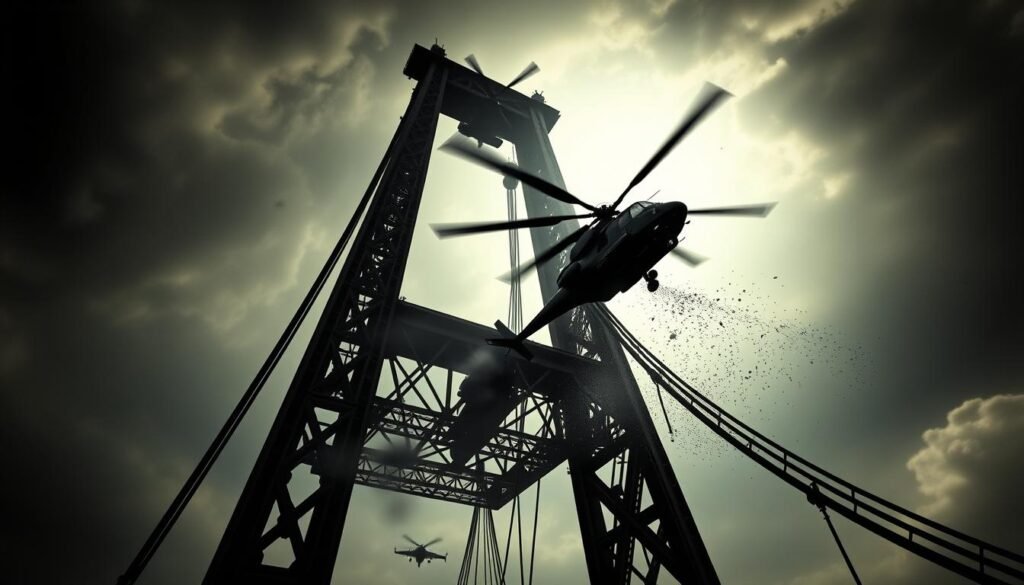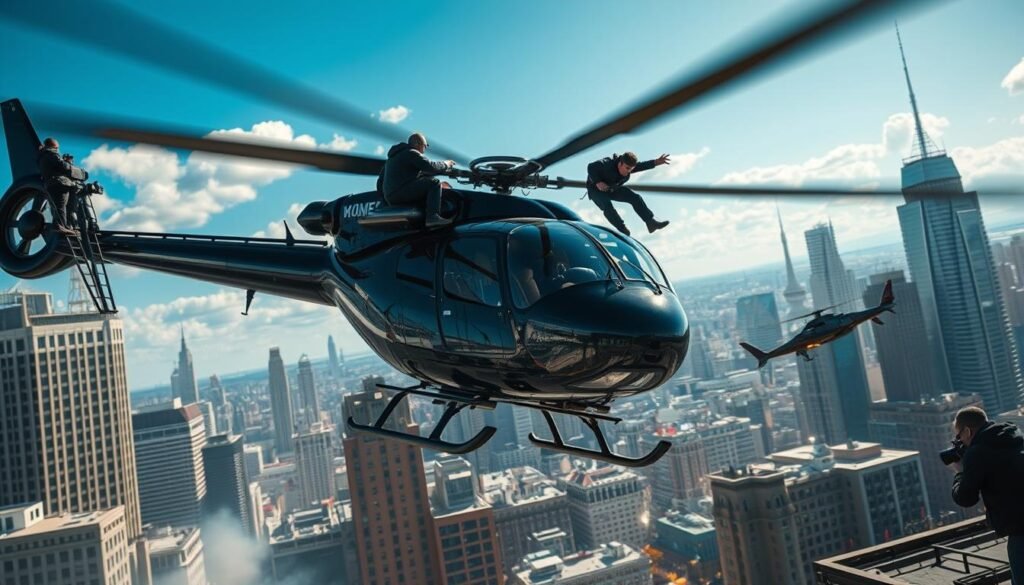Filming Helicopter Stunts in Blockbuster Movies opens with a small, tense moment on a foggy morning over Atlanta. A pilot checks fuel while a camera operator tightens a custom rig. They whisper the plan and the director gives a nod. The team moves as one, knowing the take must match the storyboard and safety plan.
Tom Cruise trained to 2,000 flight hours to perform a dramatic barrel roll, and a custom in‑cockpit camera proved he flew the craft himself. Another famous setup had pilot Fred North use a rope ladder over a bridge with a picture ship and a camera ship after months of permits and practice.
The section explains why a helicopter stayed central to big-screen action and how pilots, aerial coordinators, and camera teams balanced risk, timing, and story. Readers will learn what audiences miss during fast scenes: mapping flight paths, safety zones, and the choreographed teamwork on sets that made those moments real.
Key Takeaways
- High-stakes aerial work required planning, permits, and months of rehearsal.
- Pilots and aerial units balanced safety, logistics, and storytelling.
- Custom camera rigs enabled authentic in‑cockpit footage for credibility.
- Historic aerials set standards that teams still follow today.
- Case studies show the gap between what is cinematic and what is operationally safe.
- For deeper behind-the-scenes detail, see a focused report on how aerial sequences are planned.
- For notable examples and viewing suggestions, consult a curated list of top helicopter-centered films.
Filming Helicopter Stunts in Blockbuster Movies: What Audiences Don’t See
helicopters often supply the scale and motion that define modern action cinema.
What Viewers Miss
Audiences rarely see scouts removing streetlights, crews closing blocks, or city and FAA approvals that permit low passes over dense areas. Iconic aerials — The Shining’s 1980 Rockies shot and Heat’s 1995 downtown chase — came after weeks of planning and many resets.
User Intent And What This Guide Covers
The guide breaks down how a pilot and production turned storyboards into safe operations. It explains why some teams still choose a helicopter today when drones cannot match speed, depth, or shot windows.
From Aerial Spectacle To On-Set Realities
Fred North and other veterans describe assembling complex sequences piece by piece. A single clean scene often required coverage over many takes and a lot of specialist experience on the ground.
| Element | What Happens | Why It Matters |
|---|---|---|
| Ground Scouts | Mark hazards and plan routes | Ensures safe flight corridors |
| City & FAA Permits | Formal approvals and time windows | Legal clearance for urban aerial work |
| Resets & Coverage | Multiple takes for one moment | Creates cinematic continuity |
| Obstacle Removal | Temporarily remove street fixtures | Reduces collision risk |
Inside The Process: Pilots, Cameras, Safety, And Permits
Pilot crews train for repeatable precision so a single pass can be captured from multiple angles.
Training To Fly The Scene
Training To Fly The Scene: From In-Flight Hours To Precision Maneuvers
Tom Cruise logged 2,000 helicopter flight hours before attempting complex maneuvers, showing why productions want a pilot who can deliver the same line on demand.
On-Board Camera Rigs And Shotover Systems For Aerial Cinematography
Teams used rigid in‑cockpit mounts and Shotover K1/F1 gimbals to stabilize shots. Door placement and aircraft balance mattered for frame stability at speed.

Risk Assessment, Crew Positioning, And Safety Tethers
Safety protocols covered engine‑out scenarios, hover zones, and where a stuntman or crew stood relative to rotor wash. Human external cargo used certified tethers and redundancies.
City And FAA Permits, Flight Paths, And Ground Scouts
Ground scouts mapped flight paths and altitudes, removed obstructions, and supported permit packages submitted to the FAA and cities for constrained areas.
Helicopters Versus Drones: Why Speed, Depth, And Feel Still Matter
Drones supplemented coverage but could not match endurance, parallax or the in‑air decision making a pilot and camera operator provided for decisive coverage today.
Building The Aerial Team: Picture Ship, Camera Ship, And Communication
The picture ship, camera ship, radio discipline, and slate practices let second unit production sync shots while keeping the job safe and efficient.
For pilots transitioning roles, see a practical guide on advanced techniques for pilots making the switch.
Case Studies From Set: Mission Sequences, Bridges, And Barrel Rolls
mission case studies show how pilot skill and camera design made daring sequences feel immediate and real.
Mission: Impossible — Fallout put that theory to work. Tom Cruise logged 2,000 flight hours and flew a 360° barrel roll while a custom rig captured authentic in‑cockpit footage. That preparation let the crew craft a single, continuous shot that sells high risk without obvious cuts.
Bad Boys For Life centered on a tense bridge transfer. Fred North hovered an AStar while a stuntman climbed a rope ladder from a flatbed truck. The camera ship orbited to hold a clean angle as practical explosions fired and permits controlled timelines and building access.
Classic aerial pieces taught further lessons. The Shining and Heat used aircraft to give scale and geography. Cliffhanger used close proximity to mountain faces to heighten peril and shape audience feeling.
- Pilot Calls: Precise voice work kept each pass repeatable.
- Safety: Mapped exclusion zones, tethers, and door management cut risk.
- Coordination: Crew splits let picture and camera ships align coverage across resets.

Conclusion
Stunts read as real when pilots, the camera crew, and the team build every scene on physics and strong safety plans.
The most remembered shot often hides months of risk assessment, permit work, and small door procedures that keep people safe. Practical passes in films like Mission: Impossible — Fallout and Bad Boys For Life show how tethers, in‑cockpit rigs, and disciplined radios produced decisive, tactile effects the audience felt.
That craft depends on judgment as much as joystick skill. Experience gained year after year raised margins and made later scenes safer and more convincing.
For a focused account of one production’s methods, see a report on the making of Mission: Impossible. For technical planning and safety detail, consult this behind‑the‑scenes guide.



